
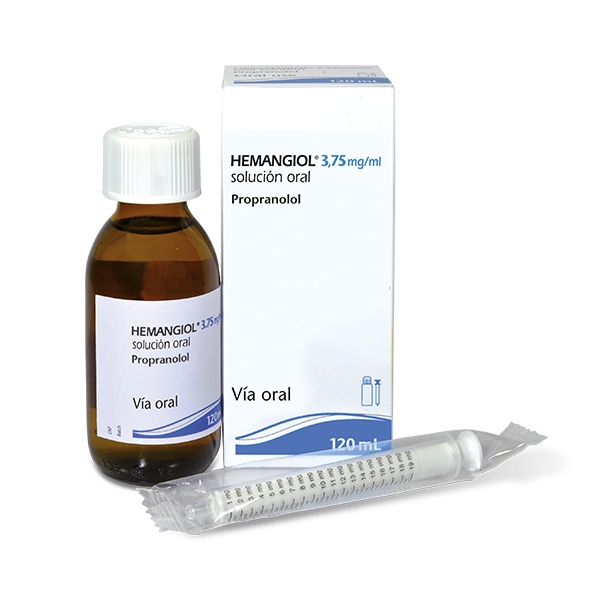
ГЕМАНГІОЛ 3,75 мг/мл ОРАЛЬНИЙ РОЗЧИН

Запитайте лікаря про рецепт на ГЕМАНГІОЛ 3,75 мг/мл ОРАЛЬНИЙ РОЗЧИН

Інструкція із застосування ГЕМАНГІОЛ 3,75 мг/мл ОРАЛЬНИЙ РОЗЧИН
Введення
Опис: інформація для користувача
HEMANGIOL 3,75 мг/мл, пероральна суспензія
пропранолол
Уважно прочитайте увесь опис перед тим, як ваша дитина почне приймати цей препарат, оскільки він містить важливу інформацію для вас.
- Збережіть цей опис, оскільки вам може знадобитися знову його прочитати.
- Якщо у вас є якісь питання, проконсультуйтеся з вашим лікарем або фармацевтом.
- Цей препарат призначений лише для вашої дитини, і не давайте його іншим людям, навіть якщо вони мають相同ні симптоми, оскільки це може зашкодити їм.
- Якщо ваша дитина відчуває побічні ефекти, проконсультуйтеся з вашим лікарем або фармацевтом, навіть якщо це побічні ефекти, які не наведені в цьому описі. Див. розділ 4.
Зміст опису
- Що таке HEMANGIOL і для чого він використовується
- Що потрібно знати перед тим, як ваша дитина почне приймати HEMANGIOL
- Як приймати HEMANGIOL ваша дитина
- Можливі побічні ефекти
- Збереження HEMANGIOL
- Зміст упаковки та додаткова інформація
1. Що таке HEMANGIOL і для чого він використовується
Що таке HEMANGIOL
Назва вашого препарату - HEMANGIOL. Активний інгредієнт - пропранолол.
Пропранолол належить до групи препаратів, відомих як бета-блокатори.
Для чого він використовується
Цей препарат використовується для лікування захворювання, яке називається гемангіома. Гемангіома - це надмірна кількість кровеносних судин, які утворили пухлину на шкірі або під нею. Гемангіома може бути поверхневою або глибокою. Іноді її називають "полоском малини", оскільки поверхня гемангіоми трохи нагадує малину.
Гемангіол починається в дітей, яким від 5 тижнів до 5 місяців, коли:
- локалізація та/або поширення уражень загрожують життю або функції органу (можуть порушити життєво важливі органи або органи чуття, такі як зір або слух);
- гемангіома виразкова (тобто, рана на шкірі, яка не загоюється) і болюча, і/або не реагує на базові заходи догляду за ранами;
- існує ризик постійних рубців або деформації.
2. Що потрібно знати перед тим, як ваша дитина почне приймати HEMANGIOL
Не використовуйте HEMANGIOL
Якщо ваша дитина:
- народилася передчасно і не досягла виправленого віку 5 тижнів (виправлений вік - це вік, який мав би бути у дитини, якщо б вона народилася в передбачувану дату);
- алергічна на пропранолол або на будь-який інший компонент цього препарату (перелічені в розділі 6). Алергічна реакція може включати висип, свербіж або труднощі з диханням;
- має бронхіальну астму або історію дихальних труднощів;
- має повільну серцеву частоту для свого віку. Ви повинні проконсультуватися з вашим лікарем, якщо не впевнені;
- має серцеву проблему (таку як порушення серцевого ритму та серцевої недостатності);
- має дуже низький артеріальний тиск;
- має циркуляторні проблеми, які роблять пальці ніг і рук онімілими та блідими;
- має схильність до низького рівня цукру в крові;
- має підвищений артеріальний тиск через пухлину надниркових залоз. Це називається "феохромоцитома".
Якщо ви годуєте свою дитину грудьми і якщо приймаєте препарати, які не повинні використовуватися з HEMANGIOL (див. "Якщо ви годуєте свою дитину грудьми" і "Використання HEMANGIOL з іншими препаратами"), не давайтецей препарат вашій дитині.
Попередження та застереження
Перед тим, як ваша дитина почне приймати HEMANGIOL, повідомте вашого лікаря:
- якщо ваша дитина має проблеми з печінкою або нирками. Цей препарат не рекомендується у разі печінкової або ниркової недостатності;
- якщо ваша дитина мала будь-яку алергічну реакцію, незалежно від її походження (наприклад, препарати або харчові речовини тощо). Алергічна реакція може включати висип, свербіж або труднощі з диханням;
- якщо ваша дитина має псоріаз (хвороба шкіри, яка викликає червоні та сухі пласти шкіри), оскільки цей препарат може погіршити симптоми цієї хвороби;
- якщо ваша дитина має цукровий діабет: у цьому випадку потрібно збільшити частоту моніторингу рівня цукру в крові вашої дитини.
- якщо ваша дитина має синдром PHACE (розлад, який поєднує гемангіому та мальформації кровеносних судин, які можуть вплинути на судини головного мозку), оскільки цей препарат може збільшити ризик інсульту.
Важливі ознаки, які потрібно шукати після прийому HEMANGIOL
Ризики гіпоглікемії
Цей препарат може маскувати ознаки гіпоглікемії (також відомої як низький рівень цукру в крові). Також він може погіршити гіпоглікемію у дітей, особливо під час періоду голодування (наприклад, поганого прийому їжі, інфекції, блювоти), коли збільшуються потреби в глюкозі (простуда, стрес, інфекції), або у разі передозування. Ці ознаки можуть бути:
- Легкі: блідість, втома, потіння, тремор, серцебиття, тривога, голод, труднощі з підйомом.
- Тяжкі: надмірна сонливість, труднощі з реакцією, проблеми з годуванням, зниження температури тіла, судоми (кризи), короткі паузи в диханні, втрату свідомості.
Ризик розвитку гіпоглікемії залишається високим протягом усього періоду лікування.
Щоб уникнути ризиків гіпоглікемії,ви повинні приймати HEMANGIOL під час або одразу після їжі і уникати прийому останньої дози близько часу сну ввечері (див. розділ 3).Ви повинні годуватидостатньо ічасто вашу дитину під час лікування. Якщо ваша дитина не їсть достатньо, якщо вона має іншу хворобу або якщо блює, рекомендується пропустити дозу. НЕ ПРИЙМАЙТЕ HEMANGIOL ВАШОЇ ДИТИНИ ДО ТОГО, ЯК ВИ НАГОДИТЕ ЇЇ КОРЕКТНО. Якщо ваша дитина має будь-які ознаки гіпоглікемії під час прийому HEMANGIOL,перервіть лікування і негайно зверніться до вашого лікаря або відвезіть дитину до лікарні. Якщо дитина свідома,дайте їй рідину, яка містить цукор. |
Ризики бронхоспазму
Перервіть лікування і негайно зверніться до лікаря, якщо після прийому HEMANGIOL ваша дитина має такі симптоми, які вказують на бронхоспазм (тимчасове звуження бронхів, яке викликає труднощі з диханням): кашель, швидке або важке дихання або свистячі звуки, асоційовані або неасоційовані з синюшністю шкіри.
Перервіть лікування і негайно зверніться до лікаря, якщо ваша дитина має симптоми, подібні до простуди, асоційовані з труднощами з диханням і/або свистячими звуками, під час прийомуHEMANGIOL. |
Ризик гіпотензії та брадикардії (повільної серцевої частоти)
HEMANGIOL може знижувати артеріальний тиск (гіпотензія) і серцеву частоту (брадикардія). Через це ваша дитина повинна перебувати під тісним клінічним спостереженням і моніторингом серцевої частоти протягом 2 годин після першого прийому і після збільшення дози. Надалі під час лікування ваш лікар буде проводити періодичні клінічні огляди вашої дитини.
Перервіть лікування і негайно зверніться до лікаря, якщо ваша дитина має будь-які ознаки, такі як втома, відчуття холоду, блідість, синюшність шкіри або оmdlіння, під час прийомуHEMANGIOL. |
Ризик гіперкаліємії
HEMANGIOL може збільшувати рівень калію в крові (гіперкаліємія). У разі великої виразкової гемангіоми потрібно виміряти рівень калію в крові вашої дитини.
Якщо вашій дитині потрібно загальне знеболювання
Повідомте вашого лікаря, що ваша дитина приймає HEMANGIOL. Це пов'язано з тим, що ваша дитина може мати низький артеріальний тиск, якщо їй будуть введені певні знеболювальні препарати під час прийому цього препарату (див. "Використання HEMANGIOL з іншими препаратами"). Можливо, потрібно буде перервати прийом HEMANGIOL за至少 48 годин до знеболювання.
Якщо ви годуєте свою дитину грудьми
- Повідомте вашого лікаря перед тим, як приймати цей препарат.
- Не приймайте цей препарат, якщо ви приймаєте препарати, які не повинні використовуватися з HEMANGIOL (див. "Використання HEMANGIOL з іншими препаратами").
Використання HEMANGIOL з іншими препаратами
- Повідомте вашого лікаря, фармацевта або медсестру, якщо ви приймаєте, нещодавно приймали або можете приймати будь-які інші препарати вашій дитині. Це пов'язано з тим, що HEMANGIOL може змінювати дію інших препаратів, а деякі препарати можуть впливати на дію HEMANGIOL.
- Крім того, якщо ви годуєте свою дитину грудьми, важливо повідомити вашому лікарю, фармацевту або медсестрі про препарати, які ви приймаєте, оскільки вони можуть передаватися до грудного молока та впливати на лікування вашої дитини. Ваш лікар порадить вам, чи потрібно припинити годування грудьми чи ні.
Особливо, якщо ви годуєте свою дитину грудьми, повідомте вашому лікарю або фармацевту, якщо ви або ваша дитина приймаєте:
- препарати для лікування цукрового діабету;
- препарати для лікування серцевих і судинних проблем, таких як нерегулярні серцебиття, біль у грудях або стенокардія, підвищений артеріальний тиск або серцевої недостатності;
- препарати для лікування тривоги і депресії, а також більш серйозних проблем зі здоров'ям;
- препарати для лікування туберкульозу;
- препарати для лікування болю і запалення;
- препарати, які використовуються для зниження рівня жиру в крові;
- препарати, які використовуються для анестезії.
Якщо у вас є будь-які інші питання, проконсультуйтеся з вашим лікарем або фармацевтом.
HEMANGIOL містить натрій і пропіленгліколь
Цей препарат містить менше 23 мг натрію (1 ммоль) на дозу; це означає, що він майже не містить натрію.
Цей препарат містить 2,08 мг пропіленгліколю/кг/добу. Якщо ваша дитина молодша 4 тижнів, проконсультуйтеся з вашим лікарем або фармацевтом, особливо якщо вашій дитині були призначені інші препарати, які містять пропіленгліколь або алкоголь.
3. Як приймати HEMANGIOL ваша дитина
Лікування вашої дитини було розпочато лікарем, який має досвід у діагностиці, лікуванні та управлінні гемангіомою у дітей.
Слідуйте точно інструкціям щодо прийому цього препарату вашою дитиною, які вказані вашим лікарем або фармацевтом. У разі сумнівів проконсультуйтеся з вашим лікарем або фармацевтом знову.
Ніколи не змінюйте самостійно дозу, яку приймає ваша дитина. Усі збільшення дози та всі корекції за вагою вашої дитини повинні проводитися вашим лікарем.
Доза
- Доза базується на вагі вашої дитини згідно з наступним схемою:
Тижні (добова доза) | Доза на прийом | Години прийому |
Перший тиждень (1 мг/кг/добу) | 0,5 мг/кг |
|
Другий тиждень (2 мг/кг/добу) | 1 мг/кг | |
Третій і наступні тижні (3 мг/кг/добу) | 1,5 мг/кг |
.
- Коли це необхідно, можна розбавити препарат у невеликій кількості дитячого молока або соку яблука і/або апельсина, придатного для віку дитини, і прийняти його вашій дитині у бутельці. Не змішуйте препарат безпосередньо з бутелькою, повною молока або соком.
Для дітей вагою до 5 кг можна змішати дозу з чайною ложкою дитячого молока (приблизно 5 мл). Для дітей вагою понад 5 кг можна змішати дозу з столовою ложкою дитячого молока або фруктового соку (приблизно 15 мл).
Використовуйте суміш у течение 2 годин після її підготовки.
Як приймати HEMANGIOL ваша дитина
- Гемангіол призначений для перорального прийому.
- Препарат повинен прийматися під час годування дитини або одразу після нього.
- Доза завжди повинна вимірюватися за допомогою пероральної джерингі, яка постачається з флаконом.
- Препарат повинен прийматися безпосередньо в рот вашої дитини за допомогою пероральної джерингі, яка включена до складу флакона.
- Годуйте свою дитину часто, щоб уникнути тривалого голодування.
- Якщо ваша дитина не їсть, або якщо блює, рекомендується пропустити дозу.
- Якщо ваша дитина блює дозу, або якщо ви не впевнені, чи прийняла вона весь препарат, не давайте їй іншу дозу, просто чекайте наступної запланованої дози.
- Одна і та ж людина повинна приймати HEMANGIOL і годувати дитину, щоб уникнути ризику гіпоглікемії. Якщо беруть участь різні особи, важливо забезпечити хорошу комунікацію, щоб гарантувати безпеку вашої дитини.
Інструкції з використання:
- Пункт 1. Вийміть з упаковки різні елементи
Упаковка містить наступні елементи, які вам знадобляться для прийому препарату:
- Склянка з вмістом 120 мл пероральної суспензії пропранолола.
- Пероральна джерингі-дозатор у мг, яка постачається з цим препаратом.
Вийміть з упаковки склянку і пероральну джерингі, і вийміть джерингі з пластикового пакету.
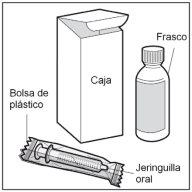
- Пункт 2. Перевірте дозу
Перевірте дозу HEMANGIOL у міліграмах (мг), яку призначив ваш лікар.
Знайдіть це число на пероральній джерингі.
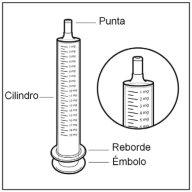
- Пункт 3. Відкрийте склянку
Склянка має кришку, яка запобігає випадковому відкриттю. Це спосіб її відкриття: натисніть на пластикову кришку вниз, одночасно повертаючи її проти годинникової стрілки (вліво).
Не потрясайте склянку перед її використанням.
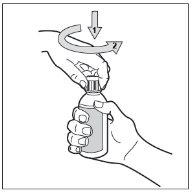
- Пункт 4. Вставте джерингі
Вставте ніжку пероральної джерингі у склянку у вертикальному положенні і натисніть на поршень повністю.
Не виймайте адаптер для джерингі з горла склянки.
Використовуйте лише пероральну джерингі, яка постачається з препаратом, для вимірювання і прийому дози. Не використовуйте ложку чи будь-який інший пристрій для видачі.
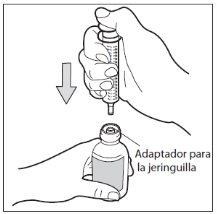
- Пункт 5: Вийміть дозу
З пероральної джерингі, встановленої, поверніть склянку догори дном. Потягніть на поршень до числа мг, яке вам потрібно.
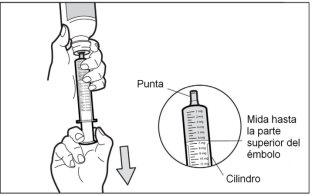
- Пункт 6: Перевірте відсутність повітряних бульбашок
Якщо ви бачите повітряні бульбашки у джерингі, тримайте джерингі вертикально, натисніть на поршень вгору достатньо, щоб виштовхнути всі великі повітряні бульбашки, і регулюйте до дози, призначеної лікарем.
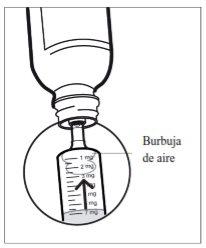
- Пункт 7. Вийміть джерингі
Поверніть склянку у вертикальне положення і відокреміть від склянки всю джерингі. Будьте обережні, щоб не натиснути на поршень під час цього кроку.
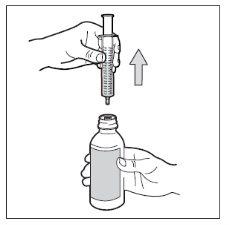
- Пункт 8. Закрийте склянку
Поверніть пластикову кришку на склянку, повертаючи її за годинниковою стрілкою (вправо).
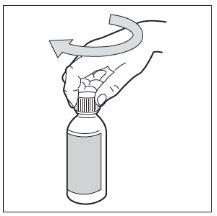
- Пункт 9. Препарат HEMANGIOL вашій дитині
Вставте джерингі у рот вашої дитини і підтримайте її всередині щоки.
Тепер ви можете повільно видавити HEMANGIOL з джерингі безпосередньо у рот вашої дитини.
Не кладіть дитину одразу після прийому препарату.
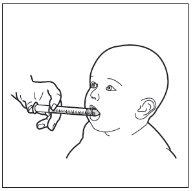
- Пункт 10: Очистіть джерингі.
Не розбирайте джерингі. Промийте порожню джерингі у склянці з чистою водою після кожного використання:
1- Візьміть склянку з чистою водою
2- Потягніть на поршень до кінця
3- Вийміть воду у раковину
4- Повторіть 3 рази цей процес очищення.
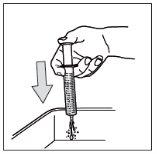
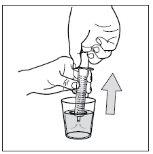
Не використовуйте жодний продукт з милом або алкоголем для очищення. Протирайте зовнішню частину джерингі тканиною. Не вводьте джерингі у стерилізатор чи у посудомийну машину.
Зберігайте склянку і джерингі разом у упаковці до наступного використання, у безпечному місці, недоступному для дитини. Вийміть джерингі, коли склянка буде порожня.
Якщо ви приймаєте більше HEMANGIOL, ніж потрібно
Якщо ви прийняли більше HEMANGIOL, ніж потрібно, негайно зверніться до вашого лікаря.
Якщо ви забули прийняти HEMANGIOL вашій дитині
Пропустіть забуту дозу, і не приймайте подвійну дозу, щоб компенсувати забуті дози. Продовжуйте лікування з звичайною частотою. Одна доза вранці і одна доза пізно ввечері.
Якщо ви перервали лікування вашої дитини з HEMANGIOL
HEMANGIOL можна припинити приймати раптово в кінці лікування, згідно з рішенням лікаря.
Якщо у вас є будь-які інші питання щодо використання цього препарату, проконсультуйтеся з вашим лікарем або фармацевтом.
4. Можливі побічні ефекти
Як і всі лікарські засоби, цей лікарський засіб може викликати побічні ефекти, хоча не всі люди їх відчувають.
Крім того, після введення ГЕМАНГІОЛу потрібно шукати важливі ознаки небезпеки можливих побічних ефектів, таких як низький артеріальний тиск, низька частота серцевих скорочень, низький рівень цукру в крові або бронхоспазм (затруднення дихання). Див. розділ 2 цього листка.
Побічні ефектидуже часті (можуть впливати на більше 1 з 10 осіб):
- бронхіт (запалення бронхів),
- розлади сну (безсоння, поганий сон і труднощі з пробудженням),
- діарея та блювота.
Побічні ефектичасті (можуть впливати до 1 з 10 осіб):
- бронхоспазм (затруднення дихання),
- бронхіоліт (запалення малих бронхів з затрудненням дихання і свистінням у грудній клітці, пов'язаним з кашлем і гарячкою),
- зниження артеріального тиску,
- зниження апетиту,
- агітація, кошмари, ірритабільність,
- сонливість,
- холодні кінцівки,
- запор, біль у животі,
- еритема (червоність шкіри).
- Дерматит підгузка.
Побічні ефектирідкі (можуть впливати до 1 з 100 осіб):
- розлади провідності або ритму серця (повільні або нерегулярні серцеві скорочення),
- уртикарія (алергічна реакція шкіри), алопеція (втата волосся),
- зниження рівня цукру в крові,
- зниження кількості лейкоцитів (клітин білої крові).
Частота наступних побічних ефектівневідома (не може бути оцінена на основі наявних даних)
- конвульсії (припадки) пов'язані з гіпоглікемією (абормально низьким рівнем глюкози в крові),
- брадикардія (абормально низька частота серцевих скорочень),
- низький артеріальний тиск,
- дуже низькі показники лейкоцитів (клітин білої крові), які борються з інфекціями,
- проблеми з циркуляцією крові, які роблять пальці ніг і рук онімілими та блідими,
- підвищення рівня калію в крові.
Звіт про побічні ефекти
Якщо ваша дитина відчуває будь-який побічний ефект, проконсультуйтеся з лікарем або фармацевтом, навіть якщо це побічні ефекти, які не вказані в цьому листку. Ви також можете повідомити про них безпосередньо через національну систему повідомлення, включену до Додатка V. Завдяки повідомленню про побічні ефекти ви можете допомогти надати більше інформації про безпеку цього лікарського засобу.
5. Зберігання ГЕМАНГІОЛу
Тримати цей лікарський засіб поза зоною видимості та доступу дітей.
Не використовувати цей лікарський засіб після закінчення терміну придатності, вказаного на коробці та на етикетці флакона. Термін придатності - останній день місяця, який вказано.
Зберігати флакон у зовнішній упаковці для захисту від світла. Тримати флакон і шприц для перорального використання в футлярі між кожним застосуванням. Не заморожувати.
Після першого відкриття флакона лікарський засіб повинен бути використаний протягом максимум 2 місяців.
Лікарські засоби не повинні бути викинуті у водопровідні труби чи у сміття. Спитайте у свого фармацевта, як позбутися упаковок та лікарських засобів, які вам вже не потрібні. Таким чином, ви допоможете захистити навколишнє середовище.
6. Зміст упаковки та додаткова інформація
Склад ГЕМАНГІОЛу
- Активна речовина - пропранолол. Кожен мл містить 4,28 мг гідрохлориду пропранололу, що еквівалентно 3,75 мг/мл пропранололу.
- Інші складові частини - гідроксієтилцелюлоза, содій сакаринат, аромат клубники (містить пропіленгліколь), аромат ваніль (містить пропіленгліколь), цитринова кислота моногідрат і очищена вода. Для більшої інформації див. розділ 2 у "ГЕМАНГІОЛ містить натрій та пропіленгліколь".
Вигляд ГЕМАНГІОЛу та зміст упаковки
- ГЕМАНГІОЛ - прозора безбарвна або легкий жовтий розчин для перорального застосування з фруктовим запахом.
- Надходить у скляному флаконі коричневого кольору об'ємом 120 мл з кришкою, захищеною від дітей. Упаковка містить 1 флакон.
- До кожного флакона додається шприц для перорального застосування з поліпропілену для дозування у мг пропранололу.
Власник дозволу на маркетинг
PIERRE FABRE MEDICAMENT
Les Cauquillous
81500 Lavaur
ФРАНЦІЯ
Відповідальний за виробництво
FARMEA
10 rue Bouché Thomas
ZAC Sud d’Orgemont
49000 ANGERS
ФРАНЦІЯ
О
PIERRE FABRE MEDICAMENT PRODUCTION
Site PROGIPHARM, Rue du Lycée
45500 GIEN
ФРАНЦІЯ
Ви можете запитати додаткову інформацію про цей лікарський засіб, звернувшись до місцевого представника власника дозволу на маркетинг.
Дата останньої ревізії цього листка:
Детальна інформація про цей лікарський засіб доступна на сайті Європейського агентства з лікарських засобів: http://www.ema.europa.eu.

Скільки коштує ГЕМАНГІОЛ 3,75 мг/мл ОРАЛЬНИЙ РОЗЧИН в Іспанії у 2025 році?
ГЕМАНГІОЛ 3,75 мг/мл ОРАЛЬНИЙ РОЗЧИН коштує в середньому 225.59 євро у листопад, 2025 році. Ціна може змінюватися залежно від регіону, аптеки та наявності рецепта. Рекомендуємо перевіряти актуальну вартість у місцевих аптеках або через онлайн-сервіси.
- Країна реєстрації
- Середня ціна в аптеках225.59 EUR
- Діючі речовини
- Потрібен рецептТак
- Виробник
- Інформація є довідковою і не є медичною порадою. Перед прийомом будь-яких препаратів обов'язково проконсультуйтеся з лікарем. Oladoctor не несе відповідальності за медичні рішення, прийняті на основі цього контенту.
- Альтернативи до ГЕМАНГІОЛ 3,75 мг/мл ОРАЛЬНИЙ РОЗЧИНФорма випуску: ТАБЛЕТКА, 10 мгДіючі речовини: propranololВиробник: Accord Healthcare S.L.U.Потрібен рецептФорма випуску: ТАБЛЕТКА, 40 мгДіючі речовини: propranololВиробник: Accord Healthcare S.L.U.Потрібен рецептФорма випуску: ТАБЛЕТКА, 10 мгДіючі речовини: propranololВиробник: Aurovitas Spain, S.A.U.Потрібен рецепт
Аналоги ГЕМАНГІОЛ 3,75 мг/мл ОРАЛЬНИЙ РОЗЧИН в інших країнах
Найкращі аналоги з тією самою діючою речовиною та терапевтичним ефектом.
Аналог ГЕМАНГІОЛ 3,75 мг/мл ОРАЛЬНИЙ РОЗЧИН у Польща
Аналог ГЕМАНГІОЛ 3,75 мг/мл ОРАЛЬНИЙ РОЗЧИН у Україна
Лікарі онлайн щодо ГЕМАНГІОЛ 3,75 мг/мл ОРАЛЬНИЙ РОЗЧИН
Консультація щодо дозування, побічних ефектів, взаємодій, протипоказань та поновлення рецепта на ГЕМАНГІОЛ 3,75 мг/мл ОРАЛЬНИЙ РОЗЧИН – за рішенням лікаря та згідно з місцевими правилами.










